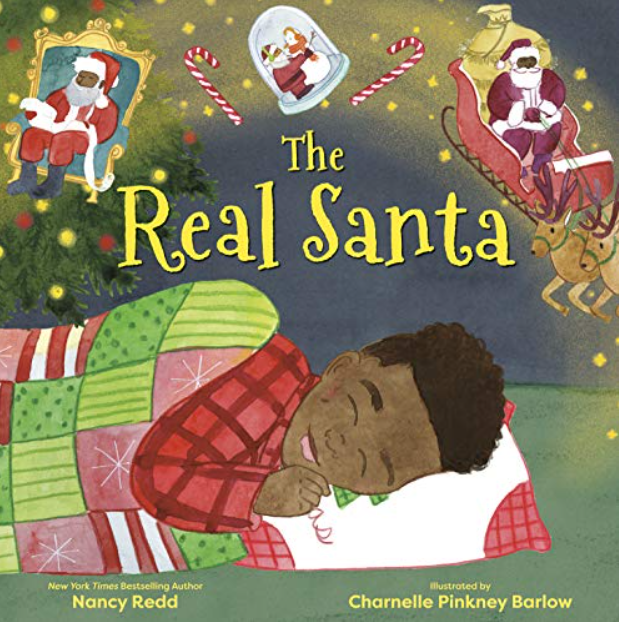Black Santa Claus gets the spotlight in Nancy Redd’s ‘The Real Santa’
“It's the Black Santa story that I wish I had growing up,” said Redd.
When you think of Santa Claus, what do you see? A large belly? A big red coat? A long white beard? But what about his race? New York Times bestselling author Nancy Redd’s newest children’s book follows one Black family on their journey to find out what Santa really looks like in The Real Santa. Redd’s book is one that has everything the children’s industry needs right now: inclusivity, openness, curiosity.
“We’re getting back to the truth about Santa,” Redd said over Zoom. She donned a red Santa hat and a virtual background with a Christmas tree and a roaring fireplace behind her.

Redd said the inspiration for her new book came from her 10-year-old son. Redd’s last book Bedtime Bonnet (2020), a Georgia Children’s Book Award nominee, was based on her daughter, so Redd said she had to even the score. The main character in “The Real Santa” asks everyone he encounters what Santa looks like, and the answer he finds is what Redd said any child reading the book would want to find.
“I wanted to showcase the fact that we are all so different and we deserve to see ourselves in print,” Redd said. “It’s the Black Santa story that I wish I had growing up.”
The legend of Santa Claus dates back centuries. The modern figure of Santa is a combination of a fourth-century Greek bishop, Saint Nicholas; the English myth, Father Christmas; and the Dutch patron saint, Sinterklaas. Claus is typically depicted as jolly, all-knowing (“He sees you when you’re sleeping, he knows when you’re awake…”), and generous, shimmying down a chimney to deliver toys to children all over the world every year on Christmas Eve. Some of the most classic uses of Santa Clause’s image were Coca-Cola’s Christmas campaigns, starting in the 1930s.
Black Santas have a more complicated history in the U.S. What originally began as a 19th-century minstrel and vaudeville show character meant to portray African Americans as inferior to whites, was reclaimed by Black newspapers and entertainers.
By World War 2, Black Santas could be seen regularly in Black homes. Black Santas were even used during the Civil Rights movement by racial justice organizers as a familiar face—akin to a Rosie the Riveter or an Uncle Sam. However, Black Santas have rarely been thrust into the mainstream media.
Thanks to Redd’s new book, many Black and brown kids for the first time will be seeing a Santa Claus that looks more like them — outside of the figurines and ornaments Black families often have in their own homes.
“Times have changed,” Redd said. “If you can’t see it, you can’t be it. I grew up feeling excluded, feeling that things I saw on TV or at the movies didn’t represent me and my family. We need more mainstream opportunities to feel seen.”
Not everyone is ready to embrace a different image of Santa Claus, which is why Redd said it’s important to send a message of diversity to kids at a young age. The book will not only serve as representation for young kids of color, but as an opportunity for white children to experience a new perspective that will surely stay with them as they grow older.
“I don’t subscribe to the notion that you can’t teach an old dog new tricks, but it’s easier to train a puppy,” Redd said. “When you instill knowledge in children, you sow seeds for the future.”
She added that children are often more open-minded and accepting than adults, making the children’s book industry the perfect opportunity to flip the Christmas narrative on its head come December. And she thinks that after the civil unrest throughout 2020 and beyond, now is as good a time as ever.
“I find children’s books are just as useful to children as they are to adults,” Redd said. “We need as many stories as we can possibly get out there as soon as possible to avoid more conflict and polarizing stigmas.”
The Real Santa was released on Oct 26, 2021, from Penguin Random House.
Have you subscribed to the Grio podcasts, ‘Dear Culture’ or Acting Up? Download our newest episodes now!
TheGrio is now on Apple TV, Amazon Fire, and Roku. Download theGrio today!
More About:Books











